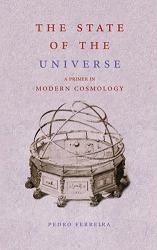
The State of the Universe
Pedro G. Ferreira
320 pages including index
published in 2006
I felt the need to reacquaint myself with modern astrophysics as it has been far too long since I've read anything about it. Sure, I do watch The History Channel's Universe series whever I catch it, but that doesn't tell me much I don't know already, while following the vast array of astronomy blogs out there is no real substitute, as they do assume a certain familiarity with the current state of the art. Long live the public library therefore, for providing quick access to what looks like exactly the book I need: The State of the Universe: a Cosmic Primer. Written by Pedro Ferreira, a lecturer in Astrophysics at Oxford, it's meant as a layperson's introduction to what astrophysics thinks the universe looks like and what makes it tick.
The State of the Universe is built up logically from first principles. Ferreira starts with a short overview of classical Ptolemaic cosmology, with the Sun revolving around the Earth and how it was succeeded by the heliocentric cosmology of Copernicus and Gallileo. Over several chapters he then shows how our knowledge of the size and complexity of the universe expanded, from what was once thought to be no bigger than our Solar System, through an understanding of how big our Galaxy actually and finally to an appreciation of the idea that all those galaxy shaped nebulas are actually galaxies as well. Then he goes on to the other end of the scale and explains the physics of the universe: the fundamental forces that shape it (gravity, electromagnetism, the strong and weak force), a quick sketch of the whole zoo of the particles that make up the matter and energy in it and how it all sits together. From the classic Big Bang idea of the evolution of the universe he finally moves on to the cutting edge of current physics, where it all gets a lot less clear what's real and what's just clever theorising.
Throughout Ferreira's focus is strictly on the astrophysics rather than the history of it. He doesn't explain how ideas and theories were developed, other than explaining how certain theories evolved or followed on from earlier, but instead explains the ideas themselves. This is perhaps more difficult to do, especially since Ferreira has to explain these ideas to an audience he cannot depend on to have any background knwoledge whatsoever. What's more, he has to do it without resorting to mathematical formulas, which is a bit awkward in a field so dominated by them. Instead there are lots of more or less illuminating analogies to help "prove" various assumptions.
Ferreira doesn't quite succeed in this. In the earlier chapters, when it's all still relatively simple, I kept stumbling over his explenations, as if missing a step in his reasoning. It almost, but not quite made sense. Whereas in the later chapters, which delves deeply into the exotica of dark matter and energie and universal topographies and so on, the explenations almost disappeared entirely. What's more, the coherence also seemed to disappear, though that's largely the fault of the material itself, which is slightly confused itself. This all made the later chapters a bit of a drag to get through.
The State of the Universe did a good job of giving an overview of astrophysics and how it evolved, but what I missed was a more coherent view of what we think the universe look at the moment and the evidence for it. Most of what Ferreira talked about I already knew, but I can hardly blame for that. For absolute beginners this is a good start, if not perfect. You certainly get a good idea of the classic view of the universe of its evolution from the Big Bang to now, if less so about how this view has evolved since.